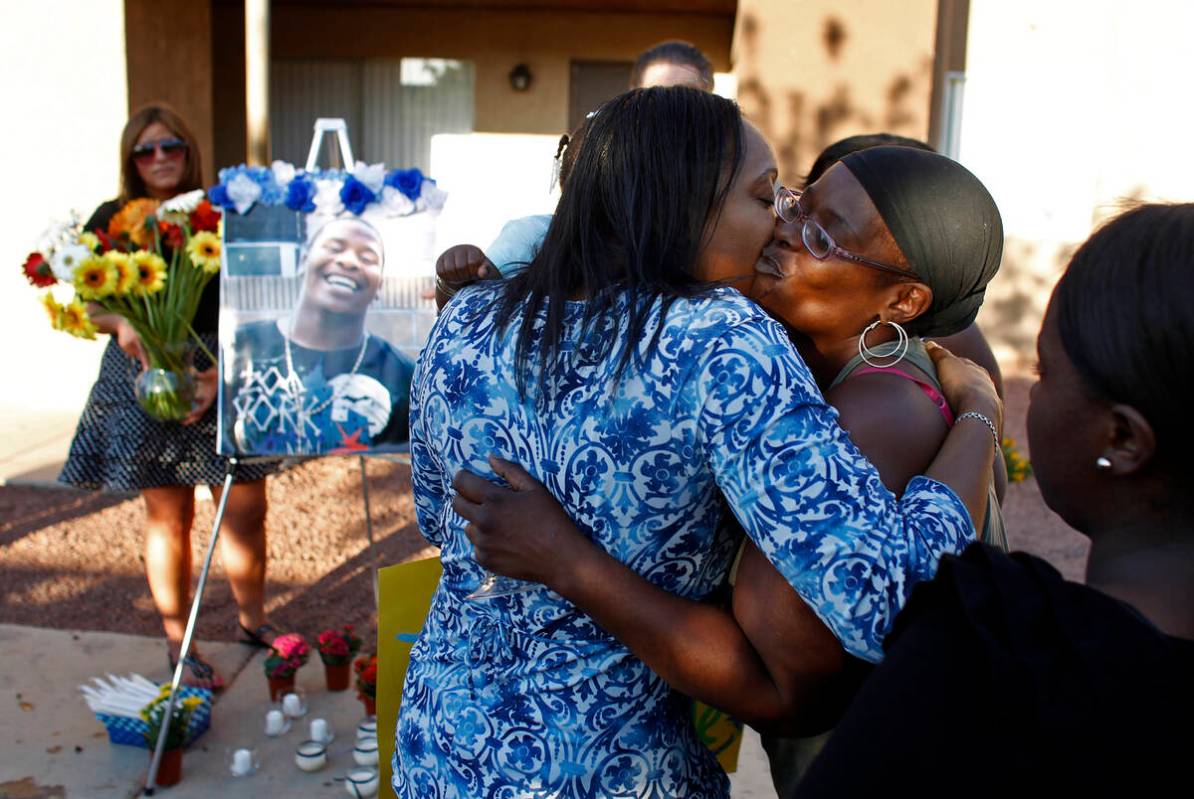A look back at controversial Las Vegas police shootings

The fatal shooting of Brandon Durham by Metropolitan Police Department officer Alexander Bookman on Thursday has prompted outrage from Durham’s family and a range of opinions from law enforcement and police use-of-force experts, with one calling the killing a “very questionable shooting” and another saying it was “objectively reasonable.”
Here is a look back at previous controversial shootings involving the Metropolitan Police Department.
Henry Rowe (1996)
In May 1996, Metro officer George “Gregg” Pease killed a homeless man named Henry Rowe while responding to a potential burglary near Dean Martin Drive and Tropicana Avenue. It was Pease’s third fatal shooting within five years.
That night, Pease approached Rowe’s desert encampment and confronted the man. Next, he said, Rowe attacked him, prompting him to slit the man’s throat and shoot him in the head. There were no witnesses to the killing.
As in both prior incidents, the officer was alone and said he was acting in self-defense when he killed Rowe. Eventually, jurors unanimously ruled in agreement — that Pease’s use of deadly force was justified.
Pease was controversial enough that former Sheriff Bill Young, Pease’s former lieutenant, had talked openly about wanting to fire Pease while he ran for sheriff in 2002.
In 2004 Pease was accused of theft: alleged misuse of his department gas card and official vehicles, the Review-Journal reported. He resigned in 2005.
Trevon Cole (2010)
Trevon Cole, according to Las Vegas Review-Journal reporting, was shot in the head by a Metro police officer during a drug raid on Cole’s east valley apartment in June 2010.
Bryan Yant, who was working with an undercover narcotics unit, targeted the 21-year-old after he bought 1.8 ounces of marijuana from Cole in four exchanges over several weeks.
Yant’s investigation was faulty, though, the Review-Journal reported. He had made mistakes like confusing Cole with someone of the same name. That person had a lengthy criminal record in other states but did not match Cole’s description or age. Still, a judge approved a search warrant with inconsistent information.
Yant’s description of what happened was also called into question in a coroner’s inquest.
Yant testified in the inquest that he kicked in the door to Cole’s pitch-black apartment to see Cole turn from flushing marijuana down the toilet and lunge toward him. He shot Cole once in the head with his AR-15 rifle, which had a broken flashlight. Yant said there was enough light in the darkened bathroom to see Cole.
Based on the position of Cole’s body, a medical examiner called Yant’s version of events extremely unlikely, and said Cole probably turned his head to look at the officer but did not lunge toward him. A prosecutor said that the evidence pointed Yant’s gun being fired accidentally simultaneous with the door kick. Yant denied it had been accidental.
The coroner’s inquest jury ruled the shooting justified.
Later investigations revealed that Yant had a history of reporting events inconsistent with evidence, as was the case in Cole’s killing. Yant ended up being one of several controversial officers identified in “Deadly Force,” the Review-Journal’s 2011 series on police shootings.
Erik Scott (2010)
On July 10, 2010, Erik Scott was shopping with his girlfriend at a Costco store in Summerlin when he drew the attention of store employees. According to them, he was tearing open water bottle packages to test whether they fit in a cooler.
One employee noticed Scott, 38, was carrying a gun in his waistband. Although Scott was legally permitted to carry the concealed weapon, the employee told him the store did not allow weapons inside.
Scott refused to leave, causing employees to call the police.
When officers arrived, they ordered that the Costco be evacuated. As customers spilled out of the store’s exit, officers Thomas Mendiola, Joshua Stark and William Mosher waited outside.
Scott and his girlfriend exited, too, and an employee pointed them out to police. Contrasting testimony said that officers either commanded Scott to get down or drop the weapon.
According to the officers and several witnesses who would later testify in a coroner’s inquest, Scott raised his Kimber .45-caliber handgun, still in its holster, toward Mosher. Officers shot him seven times.
There were dozens of witnesses, many of them doctors and lawyers, and in the days that followed, some of them doubted whether Scott pulled out a gun. Others said they did see him pull out a gun.
After six days of testimony, the coroner’s inquest jury found the three officers to have been justified in the shooting.
Stanley Gibson (2011)
After a 30-minute standoff with Metro police, Stanley Gibson was shot and killed by veteran officer Jesus Arevalo in Dec. 2011.
Confused and disoriented, Gibson roamed the Alondra Apartments near North Rainbow Boulevard and Smoke Ranch Road. Although Gibson had suffered from post-traumatic stress disorder, he was not taking his medications, which caused him to act erratically.
In the days before the shooting, officers had admitted Gibson to a local hospital for mental evaluation.
Officers responded to the apartment complex after they received a call about a prowler. They used patrol cars to surround Gibson, who was in his car, refusing to get out. The Review-Journal previously reported that he did not threaten officers, nor was he armed.
In what would be Gibson’s final phone call to his wife, he told her he could not find his way home.
After half an hour, police used a beanbag shotgun — a weapon used to disable but not kill — to break Gibson’s window. They hoped to get enough access to throw a chemical irritant inside and force him out.
However, when the shotgun was fired, Arevalo, who had been with the department for nine years and had his assault rifle aimed at Gibson’s car, also fired shots. Arevalo shot at least seven rounds, killing Gibson.
Reporting from the Review-Journal archives was used to compile this list.
Contact Akiya Dillon at adillon@reviewjournal.com.